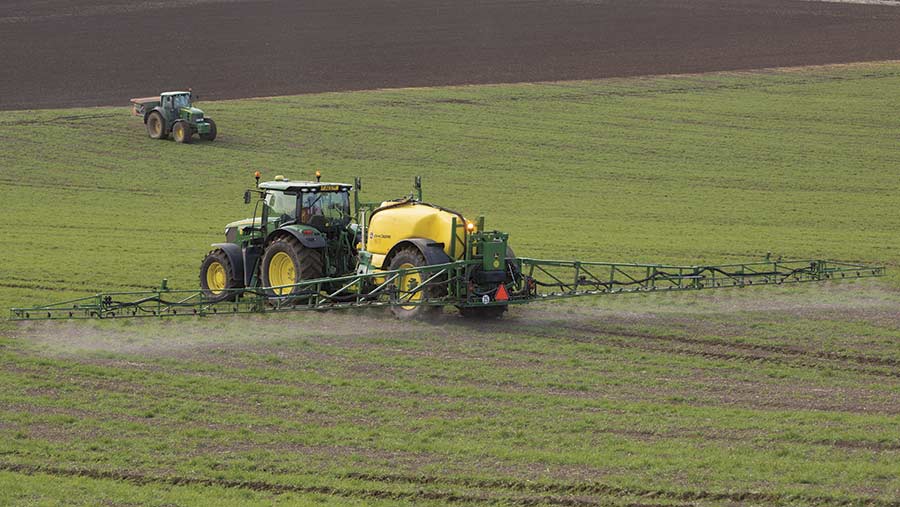Crop Watch: Workload backs up as ground conditions worsen
 © Tim Scrivener
© Tim Scrivener Wet weather continues to cause the work to pile up for our agronomists and their clients this week, with fertiliser and fungicide needing application alongside many hectares of spring drilling yet to do.
In the North, David Martindale says varieties with lower disease resistance ratings should be prioritised for management, with some winter barley showing signs of brown rust, net blotch and mildew.
Yellow rust has been an unexpected sight for Neil Potts in the West, although septoria is still the dominant disease concern in winter wheat.
See also: Septoria tools in pipeline to ‘tailor’ disease management
In spite of the recent wet weather, farmers on lighter land in the East should be acting now to conserve moisture in case of a dry spell, warns Ryan Hudson.
While the showers have stopped wheels turning in the South, Tod Hunniset says the one thing still motoring is crop growth, with residual nitrogen putting boosters under oilseed rape.
North: David Martindale
Arable Alliance (Yorkshire)

David Martindale
Spring drilling is only just beginning on the more free-draining soil types. Nitrogen fertiliser applications have been delayed, but with overall winter rainfall below average, crops have not struggled because of higher residual soil nitrogen levels.
Early-sown winter wheats look particularly well and the most advanced crops are now approaching GS30.
Differences in varietal resistance to septoria are very evident, with those scoring a 5 or less showing high levels, even when they were sown late.
Frequent rain in the past month will have caused septoria to spread further, although the symptoms cannot yet be seen.
Yellow rust is beginning to appear on susceptible varieties, but has been slower to develop so far this spring compared with recent years.
In most cases, most crops will get to the T0 timing without requiring a pre-T0 fungicide for yellow rust.
Contact-acting herbicides such as Atlantis (iodosulfuron+mesosulfuron) and Broadway Star (florasulam+pyroxsulam) are being applied now active weed growth is taking place.
Canopy control
Many oilseed rape crops have suffered quite badly from pigeon grazing in the past four weeks. Light leaf spot is evident in all crops to varying degrees and fungicides for its control are being applied, apart from where pigeons have provided their own version of light leaf spot control.
Large canopies are receiving applications that have PGR effects now they are well into stem extension. Holding off applying nitrogen to these crops is now a test of patience.
There appears to be more thistles and mayweed to clear up this spring. These weeds are often confined to headlands, but time is running out to apply herbicides such as clopyralid because of crop growth stage restrictions.
West: Neil Potts
Matford Arable (Devon)
 The dry and mild winter has meant many crops are now more advanced than they were this time last year.
The dry and mild winter has meant many crops are now more advanced than they were this time last year.
Barley crops are fast approaching T0 timing and by the time this goes to print, hopefully many crops will have received this application.
Most wheat crops are still a fortnight from T0, but continue to carry quite high levels of disease.The most prevalent is, of course, septoria, but we are seeing mildew, brown rust and – unusually for this region – also yellow rust.
Robust rates are most definitely going to be required at T0 and will need to be made up of a triazole or triazole combination and a multisite contact fungicide.
Weapons against weeds
Open crops will need to be monitored for weeds as polygonums are now beginning to germinate and come through and are not being controlled by what is left of the residual herbicide.
Wild oats are present and looking particularly healthy in many crops. These will need to be taken out early to avoid crop competition and potential application intervals where broad-leaved weed applications are to be made.
Wet ground conditions means little or no spring planting has been done yet. This is a worry as it will mean inevitable clashes in workload as the spring progresses.
I would urge growers to prioritise workload and bear in mind that where fungicide applications are concerned, timeliness is next to godliness.
If necessary, consider getting a contractor in if workloads are getting too heavy. It is crucial we get the best activity from our crop protection armoury.
East: Ryan Hudson
Farmacy (Bedfordshire/Hertfordshire)
 All crops should have by now received their first nitrogen dose as soil temperatures are increasing and crops are growing away.
All crops should have by now received their first nitrogen dose as soil temperatures are increasing and crops are growing away.
With many farms on lighter land, the general approach is to apply nitrogen early to build as big a canopy as possible, so if April and May turn dry, the fertiliser is in the plant already.
It also encourages early root development, since low winter rainfall means a dry April and May could be an issue.
Spring drilling will be commencing this week as well, with soil temperatures warm and conditions forecast to improve.
Diammonium phosphate or nitrogen will be applied to cereals ahead of the drill to ensure it is worked into the soil profile in case of a dry spell, to get it as close to the seed as possible.
Fungicide control
With grassweed herbicides applied over the past few weeks, the focus turns to fungicide applications as crops approach GS30.
As always it is crucial to identify the emerging leaf four to target any T0 fungicide applications and monitor leaf development throughout.
Barley will be the first to receive a fungicide and PGR, as most crops have now started to move. The main focus will be mildew and rust eradication and protection and maintaining as many healthy tillers as possible.
A week ago the only bit of yellow rust to be found was in Reflection, but considerably lower levels than last year, although plenty of septoria can be found on the older leaves.
Later drilling for blackgrass and more resistant varieties selected this year should help to reduce the early disease pressure, but seasonal changes to yellow rust races and varietal susceptibility means resistance ratings cannot be entirely relied upon.
Clearly there is scope to tweak fungicide inputs, but this will be driven very much by the weather over the next couple of months.
South: Tod Hunnisett
AICC (Sussex)
 Up until a couple of years ago I would take my annual holiday somewhere hot for the first two weeks in March. Very rarely would I come back to find anything had changed.
Up until a couple of years ago I would take my annual holiday somewhere hot for the first two weeks in March. Very rarely would I come back to find anything had changed.
Not so this year. I only went away for a long weekend in February and came back to find a manic hive of activity.
Stubbles being cultivated, fertiliser spreaders flying round like mad things, drills being calibrated. Unfortunately (or maybe fortunately?) the rain came along and stopped everything in its (sometimes very deep) tracks.
Except for crop growth. That very definitely hasn’t stopped, and it is continuing at an alarming rate.
Seed-bed nitrogen
After a cold, dry winter we are having a mild, wet, early spring and the crops are picking up residual nitrogen as if they have already been top-dressed.
Oilseed rape, although generally clean from disease, is getting a generous dose of growth regulatory fungicide, in many cases topped up with a proprietary growth regulator.
Early-sown wheat on fertile ground will be getting an early PGR, chlormequat plus trinexapac-ethyl.
Recommendations are going in for tidying up grassweeds. In our part of the world we are still getting reasonable results with iodosulfuron and mesosulfuron, and it still features large in our programmes.
In order to get the best out of it I always recommend that it goes on as a separate operation, not tank mixed with PGR or first fungicide. Spray quality, water volumes and ambient weather conditions have to be given full attention to optimise its effect.

